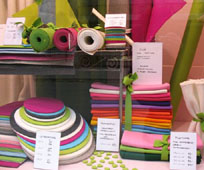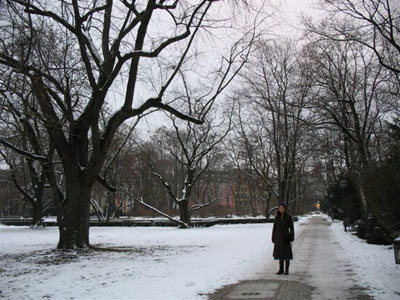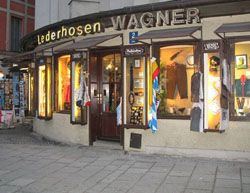Schnapp it up
Munich
by Sarah Shuckburgh
Sarah Shuckburgh finds plenty of bargains when her daughter whisks her around Munich's fabulous shopping district.
The last time I went to Munich, I came home with a cuckoo
clock and a doll in a dirndl. Today I am here with my
fashionista daughter Hannah, who tells me that the city is
one of the best - and cheapest - places in Europe to shop.
Retail therapy doesn't usually work for me, and I start to
complain about trawling a high street when I could be
visiting museums - but Hannah reassures me.

"It'll be nothing like Oxford Street, Mum. You'll love it."
We emerge from the perfectly situated Hotel Torbräu after a
hearty breakfast of meat and cheese, and step into the crisp
wintry morning. Heaps of swept snow line freshly gritted
streets and pavements. Grey clouds hide nearby Alpine peaks,
but the city glows with warm yellow stucco. On the Isar
Tower, the clock hands move anti-clockwise, Bavarian style -
and sure enough, time does seem to go backwards as we shop.
We turn down Westenriederstrasse, past antique shops
displaying an enchanting jumble of curios, and arrive at the
Viktualienmarkt. Here, every weekday since 1807,
stallholders have sold fruit and vegetables, meat and fish,
salamis and sausages, beers and wines, cheese and flowers.
We buy some sweet mustard and a spicy sausage, while under
canvas awnings, shoppers are already swigging tots of
Schnaps and mugs of beer. At a craft stall, my eye is caught
by some spookily realistic kittens, and puppies snoozing on
cushions. Are they made from stuffed corpses, we wonder, as
we stroke their fur? Hannah opts for a comfortingly fake
robin, made of twigs and straw. In a corner of the market
square, we find Holz-Leute, which since 1873 has sold
objects made of wood - toys, spoons, chess boards and
pieces, billiard cues, and beautiful wooden-handled brushes
of every conceivable size and shape.
 We
peep into St Peter's church - the oldest in Munich - and
emerge into Marienplatz just as the Glockenspiel marionettes
are performing their daily dance high on the town hall
façade. With a quick, heady inhalation in perfumer Brückner
Bublitz (established 1903), we walk up Dienerstrasse, past
Johanna Daimer's tiny shop which sells nothing but felt, and
cross the road to the Fortnum and Mason of Munich - Alois
Dallmayr. In quietly luxurious alcoves, soothing aromas waft
from a cornucopia of cakes, bread, teas and coffees - and
crayfish lurk beneath a tinkling fountain. We
peep into St Peter's church - the oldest in Munich - and
emerge into Marienplatz just as the Glockenspiel marionettes
are performing their daily dance high on the town hall
façade. With a quick, heady inhalation in perfumer Brückner
Bublitz (established 1903), we walk up Dienerstrasse, past
Johanna Daimer's tiny shop which sells nothing but felt, and
cross the road to the Fortnum and Mason of Munich - Alois
Dallmayr. In quietly luxurious alcoves, soothing aromas waft
from a cornucopia of cakes, bread, teas and coffees - and
crayfish lurk beneath a tinkling fountain.
In stately Maximilianstrasse, we join fur coated ladies
admiring the glamorous haute couture of international
designers, the chocolate confections of Elly Seidl, and the
exquisite pens and stationery of Prantl (established in
1797). Back on Residenzstrasse, a byegone age of quality and
taste is preserved in Germany's oldest shoe store
(established 1596). Eduard Meier's beautiful shop offers
monogrammed slippers, handmade riding boots, fur stoles,
shooting sticks, gun cases and tweedy coats. Stags' heads
hang from panelled walls, and a blue-aproned salesman is
polishing a pair of brogues for a customer whose hound is
lunching on the shop's special dog biscuits by the door.
We skip the Nymphenburger porcelain shop, and instead
retreat to the smoky warmth of the Tambosi café (220 years
old) with stencilled walls, glass chandeliers, marble tables
and gilt sofas. We share hot apfelstrudel and cream, and
watch admiringly as locals scoff slices cut from
cartwheel-sized cheesecakes.
Fortified by the strudel, we stroll through the snowy
Hofgarten, a formal park next to the Residenz palace. Church
bells draw us into the Italianate Theatinerkirche for
another welcome eyeful of ecclesiastical architecture before
we hit the shops again.
 A
recent flurry of urban renewal has created several upmarket
shopping courtyards and arcades, and now we explore the
Theatiner-boulevard, Fünf Höfe and surrounding streets.
Hannah is excited by the German-designed fashion - stylish
cold-weather clothes in cashmere and leather, urban chic
with a nod towards traditional costume, including felt
slippers, embroidered skirts, tight bodices and suede
breeches. With astonishing speed, she snaps up a stripy
Gabrielle Strehle cashmere jumper, a purple silk dress from
Uli Knecht, and some Miu Miu shoes from a stylish boutique
called Theresa - all bargains compared to British prices.
Helmut Lang's shop is terrifyingly stark, in black and
white, but his clothes, too, are cheaper here than at home.
Loden-Frey, a five-storey department store (established
1868) stocks more conservative apparel, including the famous
Loden coats invented by the founder's son. A
recent flurry of urban renewal has created several upmarket
shopping courtyards and arcades, and now we explore the
Theatiner-boulevard, Fünf Höfe and surrounding streets.
Hannah is excited by the German-designed fashion - stylish
cold-weather clothes in cashmere and leather, urban chic
with a nod towards traditional costume, including felt
slippers, embroidered skirts, tight bodices and suede
breeches. With astonishing speed, she snaps up a stripy
Gabrielle Strehle cashmere jumper, a purple silk dress from
Uli Knecht, and some Miu Miu shoes from a stylish boutique
called Theresa - all bargains compared to British prices.
Helmut Lang's shop is terrifyingly stark, in black and
white, but his clothes, too, are cheaper here than at home.
Loden-Frey, a five-storey department store (established
1868) stocks more conservative apparel, including the famous
Loden coats invented by the founder's son.
Passing the Roeckl family glove shop (established 1839), we
reach the 15th century Frauenkirche - Munich's best known
church, whose twin onion domes dominate the city skyline.
Inside, pale, straight-edged pillars soar peacefully towards
the distant roof.
Just outside this huge, airy basilica is Munich's answer to
Oxford Street. Kaufingerstrasse is a jostling pedestrian
strip fringed with familiar neon logos - C&A, H&M, Zara and
Bodyshop. It's Germany's busiest retail area, but luckily
it's time for lunch, so we escape down a side street to
Hundskugel (established 1440), a tiny beamed restaurant with
refreshingly few concessions to tourism or modernity. The
staff are elderly and surly, the fruit bowl contains two
mouldy satsumas and a dimpled apple on a doilly, and several
slavering dogs lick at our feet, farting pungently. But the
food is delicious. We both choose Leberknödelsuppe - lumps
of liver paté floating in beef broth.
A few steps from the restaurant lies Sendlingerstrasse -
with an attractive mix of laden old and new. We explore Kare,
a lively four-floor emporium of household goods, including
appliquéd felt cushions, and kitsch plastic cuckoo clocks.
ReSales, in the basement at number 21, is a brilliant place
to buy secondhand fur coats and hats. At Asam Pharmacy,
sleek as an art gallery with its dark oak counter and
bubbling water feature, Hannah buys some bargain Dr Hauschka
moisturiser. A tiny shop selling wallets, belts, gloves and
bags emits an intoxicating smell of leather. Once again, we
rest our aching legs in the local church, but Asamkirche is
neither pale nor peaceful - it's a mesmerising,
headache-inducing riot of baroque gold, glittering with
swags and gilded cherubs. I love it. Outside, we guzzle hot
chestnuts from a stall. Optik Paradies Suchy offers witty
spectacles in the shape of scissors, bicycles and swans, and
next door, mystic music plays in the spicily fragrant Tea
House, stacked from floor to ceiling with tempting
infusions.
At 5 o'clock, we sip warming Glühwein in the atmospheric
Hackerhaus restaurant (established 1417), served by gloomy
wenches in dirndls. For us it feels like teatime, but locals
are already quaffing beer from giant tankards, and tucking
into vast hunks of meat, mountains of potato and sauerkraut,
enormous radishes, and soft knotted brezen rolls, dotted
with lumps of salt.

On our way back to the hotel, Hannah insists on one more
detour, to explore the narrow streets north of Tal. Here we
find another cluster of tiny, quirky shops, and to my
surprise, I suddenly buy a woollen jacket, in Bavarian
shades of green. In Orlandostrasse, we decide against cuckoo
clocks this time, and buy hand-painted wooden Christmas
figures. Yards from our hotel, we stop at Lederhosen Wagner
(established 1825) - a narrow corner shop, stuffed to its
low beamed ceiling with leather breeches, felt jackets,
silver belts, string ties, and hats with tufts of chamois
hair. A wood stove warms our legs as we ponder how our
menfolk would look in lederhosen, and whether we should buy
adorable miniature versions for friends' babies.
Across the road is Wies'n Tracht & Mehr, a rambling treasure
trove stuffed with secondhand Bavarian costumes. We rummage
through hundreds of brightly coloured dirndls, green and red
woolly cardigans, white blouses with puff sleeves, laced
bodices, aprons, felt jackets, white bobbly socks, feathered
hats, clumpy shoes, lederhosen long and short, and every
other Bavarian accessory. Hannah is tempted by a complete
dirndl outfit, but finally settles for a gingham blouse.
That evening, our legs will hardly carry us the few hundred
yards from our hotel to the Haxnbauer restaurant in
Sparkassenstrasse. On a spit in the window, shiny orange
shanks of pork drip fat on to the beech-wood flames. Inside
the high-ceilinged 15th century eating hall, the air is
thick with the smell of pork. The menu is long and
complicated, and the waiters are grumpy as usual, but
finally we opt for Schweinshaxe from the spit - glistening
chunks of pork knuckle, with creamy mashed potato and
cabbage. The diners at the next table order a whole knuckle
each - vast joints as big as footballs. Afterwards they tuck
into thick apple fritters, and we do too. As we stroll back
to our hotel (established 1490), the clock on the tower is
still ticking backwards, and I agree that in Munich ancient
and modern, shopping is fun.
First published by the Telegraph
©SarahShuckburgh |